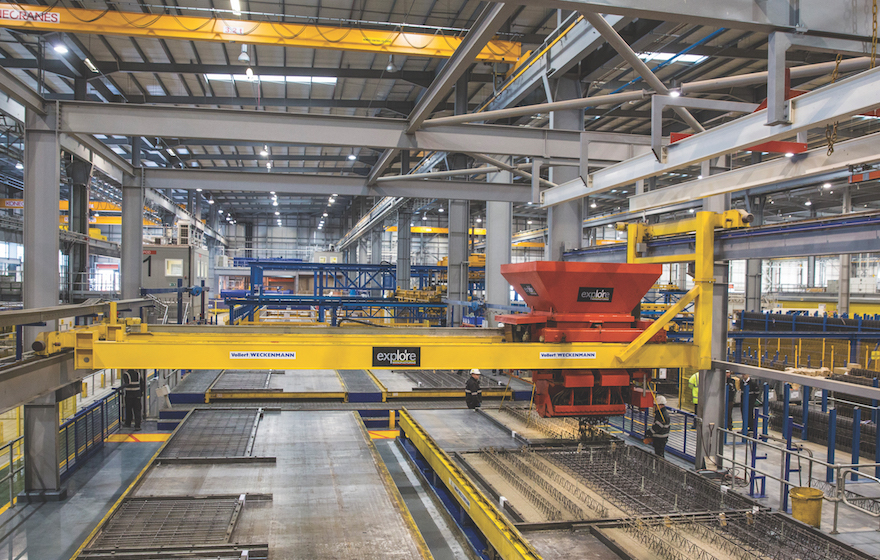Laing O’Rourke has been leading a research project to drive quality and productivity improvements through the use of digital tools, using the Hinkley Point C nuclear site and its own manufacturing facility in Worksop as demonstrators. In this first instalment, we give an overview of the project and look at the first of the project’s five deliverables.
Known as Augmented Reality for Operative Productivity and Continuous Quality Analysis (AROPCQA), the project has been led by Laing O’Rourke, working with partners tech giant Trimble, the University of Sheffield Advanced Manufacturing Research Centre (AMRC), and software SMEs Offset and WorkMobile. It got underway in April 2019, backed by funding from Innovate UK.
The technologies explored have included augmented reality (AR), laser scanning, artificial intelligence (AI) and 3D digital design, with use cases such as nuclear concrete reinforcement cage production and the manufacturing of precast units.
“We aimed to address many challenges in the construction industry’s current ways of working,” explains Dr Scott McGovern, AROPCQA project leader and digital engineering leader at Laing O’Rourke.
“These included moving away from paper drawings to digital models and authoring digital data which could be directly consumed by manufacturing and construction operatives. Other challenges are the need for more effective management of QA data, more efficient inspection processes including systems to compare digital designs with physical objects, and digital creation of as-built records.”
The two-year programme had five key project deliverables:
- Create mobile apps for manufacturing QA reporting (see below);
- AI-based feature detection for automated QA;
https://www.bimplus.co.uk/analysis/laing-orourkes-digital-push-hinkley-point-c-part-2/
- Provide mobile accessible digital ‘work packs’ to operatives;
https://www.bimplus.co.uk/analysis/laing-orourkes-digital-push-hinkley-point-c-raisin
- Virtual, augmented and mixed reality for QA;
https://www.bimplus.co.uk/analysis/laing-orourkes-digital-push-hinkley-point-c-ar-vis
- Laser scanning and point cloud data processing for as-built verification.
https://www.bimplus.co.uk/analysis/laing-orourkes-digital-push-hinkley-point-c-laser-
Developing the technology for the demonstrators was not without challenges, says McGovern.
Hinkley Point C in Somerset, where Laing O’Rourke is in joint venture with Bouygues, is the largest construction project in Europe.
“There are large volumes of work in a congested area, with increased rigour over quality standards, such as nuclear concrete requirements, plus greater rigour in tolerances and evidence of this expected at handover,” McGovern explains.
“Because of the project’s size, design is locked down six months ahead of construction, so workflows are difficult to alter to adopt new technologies.”
McGovern’s team also had to contend with existing non-digitised processes.
“For example, when we started AROPCQA, the Hinkley project team was using paper drawings for manufacturing rebar steel cages,” he notes.
Similarly, in Laing O’Rourke’s precast manufacturing plant, a high proportion of QA processes in factory were paper based.
“Most items produced are bespoke, which adds to the QA capture challenges,” McGovern adds. “There were also manual, inefficient links with the ERP (enterprise resource planning) system.”
And like the rest of the construction, AROPCQA was affected by covid-19 restrictions that came in when the demonstrators were starting. “This affected our ability to link up with our partners,” says McGovern.
Despite these challenges, the programme completed on schedule in March 2021, with further development and testing planned for the technologies used.

The Centre of Excellence in Worksop where WorkMobile is being trialled
Mobile app for manufacturing QA
Laing O’Rourke brought in software firm WorkMobile to help it move away from paper-based QA for precast units at its Centre of Excellence in Worksop.
“The aim was to replace the existing QA process with a tablet-based app for operatives to use, that would integrate with Laing O’Rourke’s ERP and feed captured data back into the ERP,” explains Colin Yates, WorkMobile co-founder.
Workmobile is cloud based, intended for field-based IT solutions and aimed at non-technical users. It uses a ‘non-coding’ approach, as opposed to being a bespoke solution, and supports multiple platforms.
The software provides a simple drag-and-drop interface to build forms, including the capability to add photos, videos, recordings, signatures and ‘geostamps’, plus Excel-style logic and barcode scanning.
The user interface is straightforward and, once the operative has completed a form, the data is sent off the device to the cloud. The data can be reviewed through the WorkMobile portal in real time and reports are generated as PDFs.
“With Laing O’Rourke, we distilled their QA process into a structured form,” explains Yates. “This involved reviewing their current process, removing unnecessary fields, changing the order where necessary, allowing for pre-population of some fields.”
WorkMobile also introduced customised features for the Laing O’Rourke app. The Schmidt Hammer calculation, a non-destructive method of testing concrete strength, required operatives to take 10 readings and then calculate this themselves, before entering the value on the paper form. This calculation has been automated with the app.
“If the readings entered by the user fail the test, then the user has to retake the test,” says Yates.
Another customised feature allows operatives to scan a barcode tag on each component to check they are working on the right unit. “A future development will allow users to see where a panel is in the manufacturing process in real time,” adds Yates.
Next for WorkMobile is a production scale pilot of the app.













